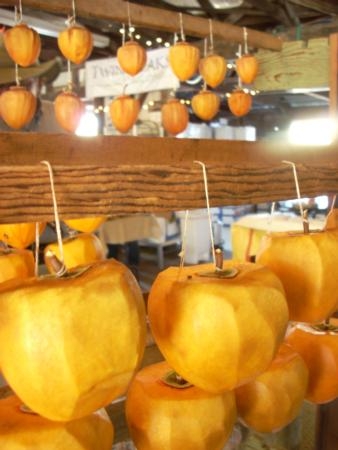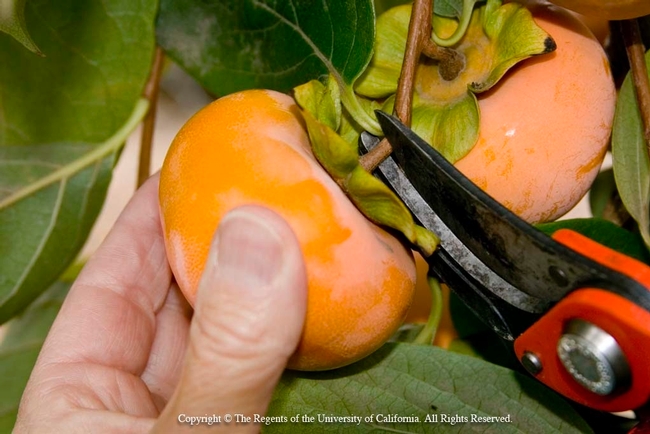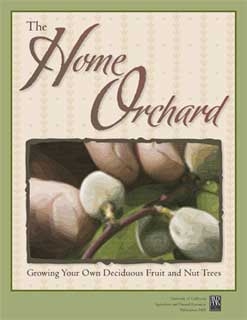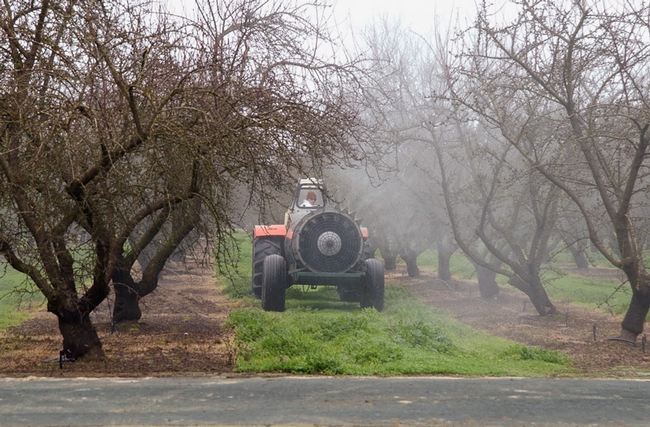Posts Tagged: orchard
UC to measure energy and greenhouse gas footprints of orchard crops
A new study underway at the UC Sustainable Agriculture and Research and Education Program (SAREP) aims to help growers and policymakers better understand the energy use, greenhouse gas emissions, and carbon sequestration potential of orchard systems throughout California.
As trees grow, they draw carbon dioxide from the air to create sugar and cellulose for food and growth, locking some of that carbon into their wood as the trees age — in some trees for 25 years, in others like walnuts, for upwards of 150 years. Proper use of that carbon at the end of an orchard's life can have major implications for the overall greenhouse gas footprint of an orchard operation. Trees used for power generation after orchard removal have the potential to offset fossil-fuel related emissions created throughout the orchard's life.
"Our preliminary study in almonds shows that the amount of fossil fuel emissions saved in this way is equal to almost three-quarters of the greenhouse gas emissions generated during the whole 25-year lifespan of the orchard, using current practices," says the project's director, Sonja Brodt, SAREP academic coordinator. "We think that this information could help to position orchard crops favorably for a consumer base that is increasingly climate-smart."
This study, funded by the California Department of Food and Agriculture's Specialty Crops Block Grant Program, will focus on prunes, peaches, walnuts and almonds in all of the primary production regions of the state.
Many farm management practices have an energy use component that the project will consider including water and fertilizer use, tractor use and post-harvest transportation. By understanding which parts of orchard operations use the most energy as well as how much energy is required to manufacture and distribute inputs before they even arrive at the farm, growers can increase the efficiency of their practices. Industry groups can also develop more scientifically-sound grower sustainability programs to improve energy efficiency more broadly for the state's many tree crop growers.
"Energy is one input into agriculture that we have not thought about much from a whole supply chain point of view," says Gabriele Ludwig of the Almond Board of California, which funded a preliminary study on energy use and emissions in almond production and handling. "Yet the costs of energy, especially from fossil fuel sources, keep going up. The life cycle assessment approach used in this project can provide an analysis of where increased efficiencies may be possible."
The project's collaborators include the UC Cooperative Extension's Sutter-Yuba office, the UC Davis Department of Civil and Environmental Engineering, Department of Land, Air, and Water Resources, the Department of Plant Sciences, and graduate students in Horticulture and Agronomy and International Agricultural Development.
By working with growers throughout the state, project staff will be able to ensure that orchard management practices included in the project's models are representative of current practices. Growers interested in providing confidential input about their orchard practices are invited to contact Brodt at sbbrodt@ucdavis.edu or (530) 754-8547.
Persimmons and hoshi gaki - An alternative to persimmon cookies
I have to admit that I am not a big fan of the flavor of persimmons with one exception … dried. Dried persimmons have a more intense flavor and make a wonderful, healthy snack. I have dried the Fuyu persimmons by just cutting the fruit horizontally into about ¼-inch thick slices and then putting them in the food dryer. It is a very easy method to preserve the fruit. They are tasty little treats but they can be a bit leathery and brittle.
This year I tried a different method of drying my fruit called hoshi gaki. In Japanese, hoshi means dried and gaki comes from kaki, the Japanese term for persimmon. This is a traditional Japanese method that uses the Hachiya variety of whole firm ripe persimmons. Normally, the Hachiya variety has to be fully soft before eating to remove the astringency. The pulp then is used in a lot of baked products or smoothies. However, with this method of drying, the fruits are perfect when they are harvested while still firm.
Fruit is typically harvested in late September through early November. Be sure you retain the stem when harvesting; you will need it to hang the fruit. The fruit is peeled, and hung whole to dry in a warm area with good air circulation and protected from rain. The fruit is allowed to hang for about 3 and 7 days until it forms a skin on the outside. The fruit is then gently hand massaged to break up the hard inner pulp. The massage process is repeated every 3 to 5 days for 3 to 5 weeks. When the fruit is ready, a bloom of sugars forms on the surface, creating a fancy white coating. You can tell when the fruit is ready when the pulp is set and you can no longer roll it around. You then remove it from the hanging rack. I like to flatten the fruit out using a rolling pin and then layer and stack the dried fruit for storage. If you package them in a fancy container, they make lovely hostess or holiday gifts.
This traditional method of processing persimmons is virtually gone from the commercial markets but there are many small growers who have the skill, dexterity and patience to process fruit in this time consuming way. You may be able to find them at your local farmers markets if you want to try them. If you have a Hachiya persimmon tree in your yard and want to find ways to use the fruit, give this method a try next year. For more information on growing persimmons check out The Backyard Orchard Website or The Home Orchard Manual

Drying whole Hachiya persimmons.
“Smart” orchard sprayers reduce pesticide use, protect waterways
Technology that allows orchard sprayers to skip the space between trees can protect the environment while saving growers money.
The idea is simple: when orchards receive dormant and in-season sprays of agricultural chemicals, the spray should only fall on the trees where it is needed, rather than on the ground, where it is not.
Orchard sprayers can be retrofit with target sensors that activate spray nozzles only when a tree is present.
A review of research on this “smart” sprayer technology, published in the April-June 2011 issue of the University of California’s California Agriculture journal, found that the financial and environmental benefits of the technology are substantial.
“By reducing the application rate of the pesticide mix, each tank load of material covers a greater land area, effectively reducing the number or refills, ferry trips and time spent spraying each orchard,” wrote author Durham Giles, UC Davis professor of biological and agricultural engineering, in California Agriculture. “This provides additional economic return to growers by reducing labor and fuel costs.”
Based on field tests, the authors estimated that reductions in pesticide and operating costs with smart-sprayer technology ranged from $58 per acre for peaches grown in the San Joaquin Valley to $31 per acre for prunes grown in the Sacramento Valley.
At the same time, reductions in the total amounts of pesticide sprayed ranged from 15 percent for a mature prune orchard near Chico, to 22 percent for a mature almond orchard near Modesto, to 40 percent for a younger (more open) prune orchard near Oroville.
The trees themselves received the same amount of pesticide in the smart-sprayed orchards, but a lot less pesticide ended up on the ground than in the control. “For the almond and more open prune orchards, the reductions were 79 percent and 59 percent, respectively,” Giles and colleagues wrote.
Likewise, when the amount of pesticide in water running off from the younger prune orchard was measured, the reduction was 54% in the smart-sprayed orchard compared to the control.
Despite its obvious benefits, the study authors noted that “use of the smart-spray technology is growing but remains a small part of the spraying equipment market.” The retrofit spray sensor and control equipment cost about $15,000, with an estimated payback period of 2 years or less, given documented cost reductions.
Furthermore, the U.S. Department of Agriculture’s Environmental Quality Incentives Program (EQIP) can provide up to $30 per acre for a total of $15,000 per contract when the new equipment provides a 20% reduction in spray, which as been documented in peer-reviewed research such as the California Agriculture article.
“The amount is sufficient to adequately cover the cost of purchasing a typical target-sensing system for an orchard sprayer,” the authors note in California Agriculture journal.




